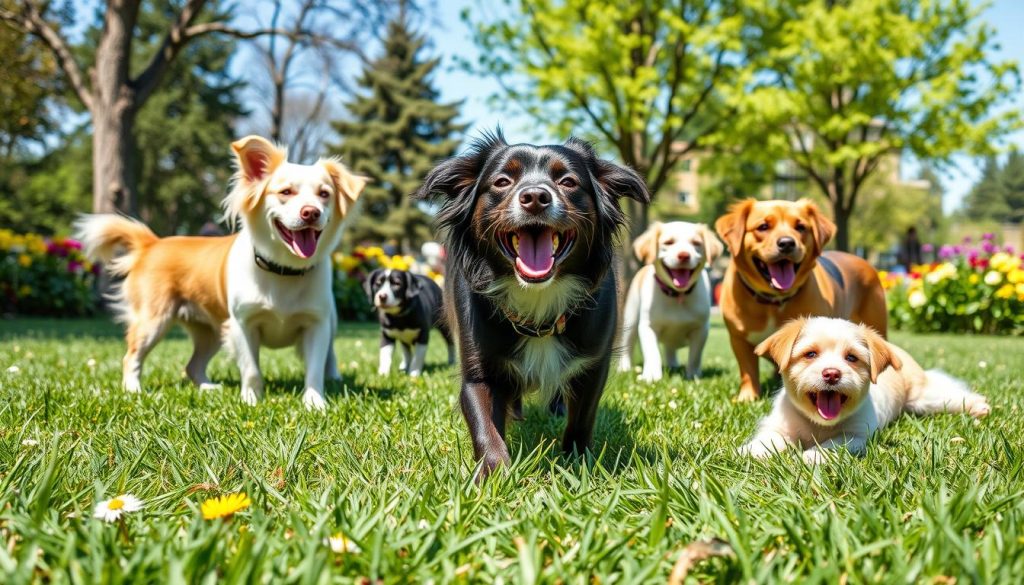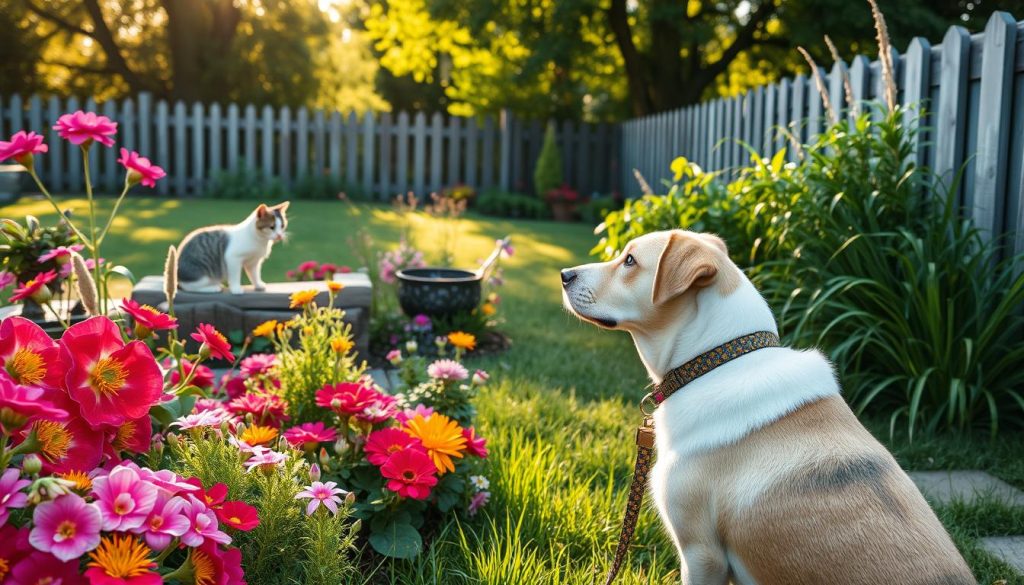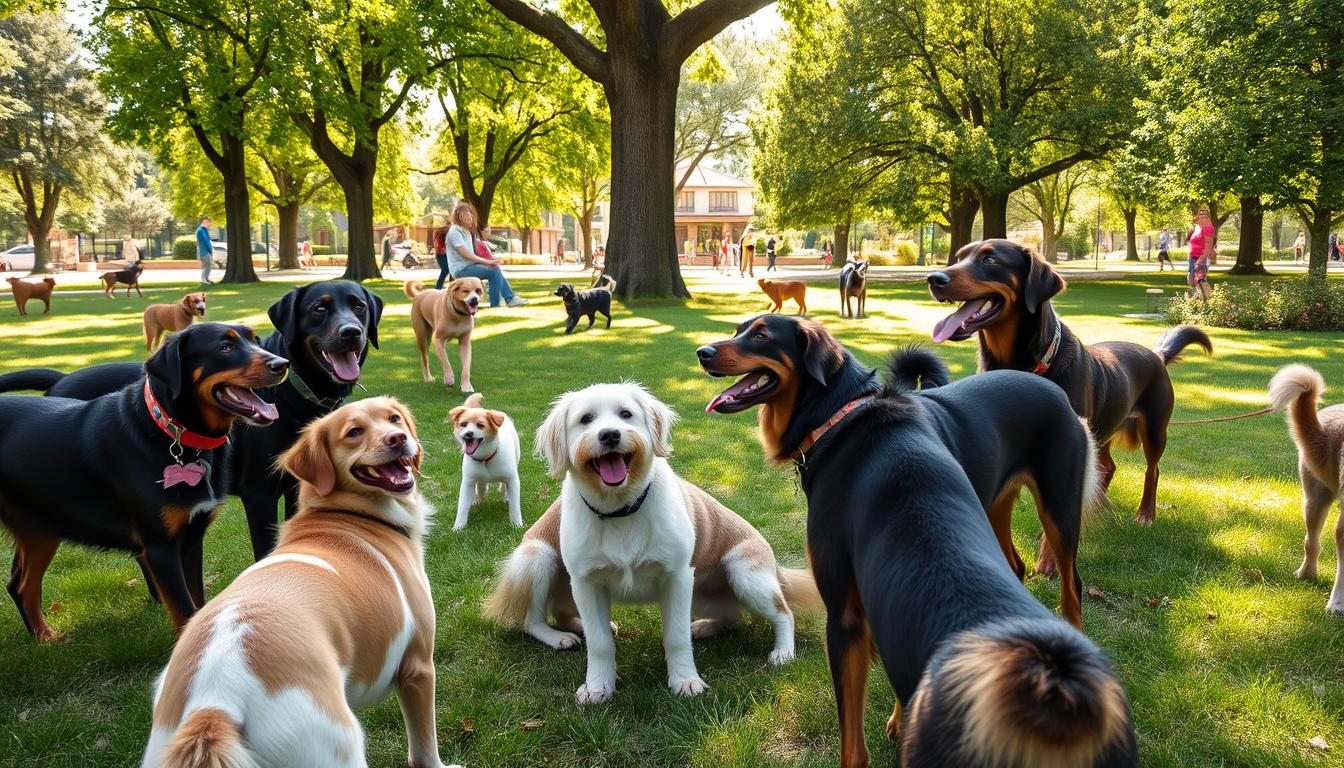Ever thought about your dog getting along with other pets at home? It might seem tough, especially in a house with many pets. But, with careful pet socialization, your home can become a place of peace and friendship.
Picture a home where all pets live together happily. Experts say early and ongoing canine behavior training is key. It helps avoid bad behavior and makes your home a joyful place.
Let’s explore how to train your dog to be friendly with other pets. This way, your home will be a happy and healthy place for all.
Introduction to Socializing Your Dog
Socializing your dog is key for its happiness and growth. It means introducing your dog to many places, people, and animals. This helps them learn how to act around others and avoid being aggressive.

Quick Recommendation : Our blog is filled with tips , tricks, and methods for training your dog. If you would like to attend the Free Dog Training Workshop, we recommend the K9 Training Institute.
Many think socializing means just meeting other dogs. But, it’s more than that. It’s about meeting different animals and being in various places. Carolyn Menteith, an animal behavior expert, says social dogs are more confident and calm. They have less fear and anxiety, making home life better.
A study by the American Veterinary Society of Animal Behavior shows how important it is. Dogs that are socialized well adjust faster and bond better with others. This shows why starting socialization early is crucial.
Preparation Before Introducing Pets

Quick Recommendation : Our blog is filled with tips , tricks, and methods for training your dog. If you would like to attend the Free Dog Training Workshop, we recommend the K9 Training Institute.
Before bringing new pets home, it’s key to get ready for them. Start by separating living areas for each pet. This lets them have their own space, reducing stress and making them feel safe.
Next, get each pet used to the other’s scent. Swap their bedding or rub a cloth on one pet and let the other sniff it. This makes their first meeting less scary.
Choosing pets with good personalities is also important. Look for advice from experts or animal groups to check if pets are a good match. This helps you understand their unique behaviors and manage their interactions better.
Finally, make sure all pets are healthy and up-to-date on their shots. This keeps them safe and healthy, making their interactions better. By following these steps, you can create a peaceful home for your pets.
Gradual Introduction Process
Patience and careful planning are key for a successful pet introduction. Start by letting both pets see each other without touching. This helps reduce anxiety and makes things more predictable.
Next, have controlled meetings where you watch their body language. Choose a calm, neutral place for these meetings. Keep them short and reward good behavior with treats and praise.
Try parallel walking as a method. Walk both pets side by side but keep them apart at first. This makes them associate with each other in a positive way, like on a walk.
Slowly bring the pets closer during walks, watching for any signs of discomfort or aggression. The goal is to build a positive association over time.
As you progress, let them have brief, supervised interactions. Keep these meetings in neutral places. Be ready to separate them if things get tense. Patience and vigilance are crucial in this process.
Studies show a careful introduction plan reduces pet stress and aggression. By following a structured plan, you’ll help your pets get along well. This creates a happy and peaceful home for everyone.
Quick Recommendation : Our blog is filled with tips , tricks, and methods for training your dog. If you would like to attend the Free Dog Training Workshop, we recommend the K9 Training Institute.
Training a Dog to Be Friendly with Other Pets
Training a dog to get along with other pets starts with building trust. Begin by letting your dog and the new pet meet in a neutral area. Watch how they act and slowly increase their time together.
Try activities like walking them together and giving treats for good behavior. This helps them associate positive things with each other. Getting advice from pet psychologists can also help. They know how to make your dog and other pets bond well.
Using toys or games can help make things friendly. The aim is to make every meeting fun, so your dog doesn’t feel territorial. This is key to successful training and a peaceful home with many pets.
Positive Reinforcement Techniques
Positive reinforcement training is a great way to teach your dog to get along with other pets. It uses rewards like treats, toys, and praise to encourage good behavior. This method makes learning fun and strengthens your bond with your dog.
Dr. Sophia Yin, a famous vet and animal behaviorist, says to reward good behavior right away. If your dog stays calm around other pets, give them a treat or their favorite toy. This makes them connect the calm behavior with something they enjoy.
Trainers from the American Kennel Club also recommend positive reinforcement. They suggest a plan where rewards decrease as the dog shows consistent good behavior. This ensures the dog keeps up the good behavior even when rewards are less often.
Positive reinforcement has big benefits for your dog’s mind. Dr. Karen Overall says dogs trained this way feel less stressed and anxious. They become more friendly and comfortable around other pets. This training not only teaches new behaviors but also boosts your dog’s emotional health.
Adding positive reinforcement to your routine can change how your dog acts around other pets. By using rewards wisely, you’re not just teaching good behavior. You’re also creating a peaceful home for all your pets.
Dealing with Aggression and Fear
Handling a pet’s aggression and fear can be tough. But knowing what these behaviors mean is crucial. By spotting stress or fear in your dog, you can make a safe place for all pets.
Start by changing your dog’s behavior to reduce fear. Watch how they act and react to things. This helps you see what scares or makes them angry. For instance, some dogs get aggressive when they feel trapped or threatened by another pet.
Redirecting your dog’s focus is a good way to stop aggression. If you see them getting tense or aggressive, try to distract them with something fun. This could be playing with a favorite toy or practicing commands. It helps stop the aggressive behavior.
Animal therapy groups like the ASPCA suggest patience and consistency in behavior change. Slowly introducing your dog to other pets, with positive rewards, teaches them to see other animals as friends, not threats.
Experts in dog aggression say to use controlled spaces for meetings. This makes your dog feel secure and not too stressed. Using baby gates or crates helps keep pets safe while they watch each other calmly.
With these steps, you can tackle aggression and fear in pets. This creates a peaceful home for all your furry friends.
Maintaining Harmony Between Pets
Keeping peace in a home with many pets takes hard work and focus. It’s key to keep up with routines and group training. This helps all pets live together well and enjoy each other’s company.
It’s important not to play favorites with your pets. Giving each one special time helps avoid jealousy. This way, they all feel loved and important.
Watching how your pets interact is crucial. This lets you spot and fix any problems early. Experts say a safe, fun space for each pet is essential. This means having separate places for food, toys, and rest.
Talking to other pet owners can be really helpful. They share tips and advice on keeping peace in your home. This way, you can learn new ways to manage your pets better.
Common Mistakes and How to Avoid Them
Training your dog to be friendly with other pets requires avoiding common mistakes. Many owners rush the socialization process, causing tension and conflict. Forcing your dog into interactions before it’s ready can increase stress and aggression.
Consistency is key in avoiding socialization mistakes. Inconsistent training confuses your dog, making it harder to learn new behaviors. Animal behaviorists say a gradual and steady pace is crucial. Start preventive pet training to prevent issues before they happen.
Dr. Sophia Yin, a well-known veterinarian and animal behaviorist, stresses the importance of positive reinforcement and patience. Reward good behavior and gradually increase socialization periods. This approach helps avoid dog training errors, leading to a well-adjusted and friendly pet.
Conclusion
Training a dog to get along with other pets needs a lot of effort, patience, and a smart plan. Starting with preparation and slow introductions, then using positive rewards, is key. Each step is important for successful dog socialization.
By handling aggression and fear well, and keeping peace, you can make a happy home for all pets. Real-life examples show how important socialization is. People have changed their homes for the better with these steps.
These stories show the big benefits of socializing pets well. They share their success stories, encouraging others to do the same. Remember, making a peaceful home for pets is a continuous effort.
Don’t be afraid to ask experts for advice that fits your situation. With the right knowledge and patience, you can create a loving space for all your pets. Start using these tips today for a happier home for everyone.
Quick Recommendation : Our blog is filled with tips , tricks, and methods for training your dog. If you would like to attend the Free Dog Training Workshop, we recommend the K9 Training Institute.

